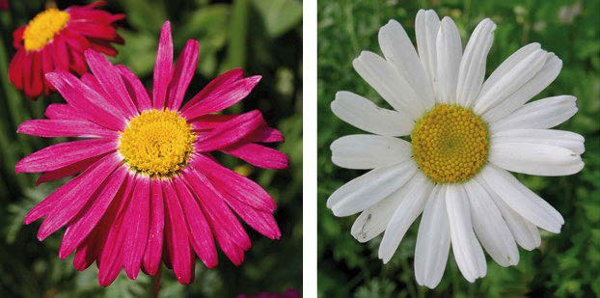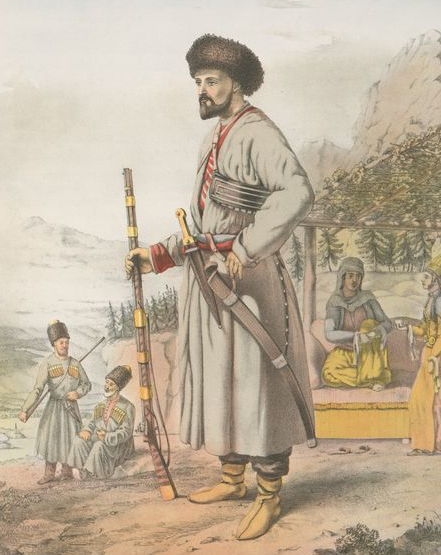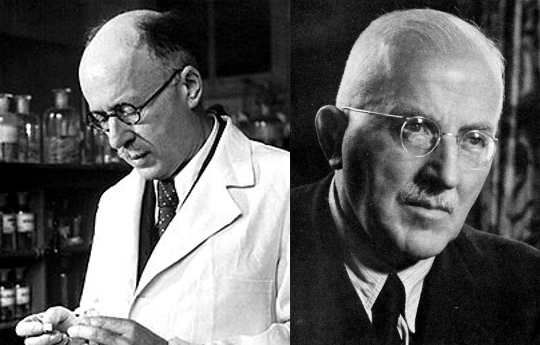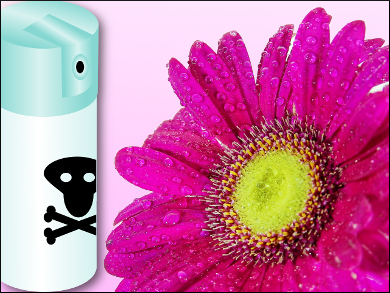Insects and people share a common habitat. From our perspective, many bugs are useful, indeed essential, as for example when they make agricultural crops possible through pollination. We are amazed, for example, by the diligence of bees and extol them in nursery rhymes and make them into movie heroes. But if insects like locusts, potato beetles, cabbage butterflies, grapevine lice, or grain weevils threaten or destroy our crops, then we regard them as parasites. And if common house flies, horseflies, cockroaches, mosquitoes, bedbugs, fleas, or lice badger us where we live, or sting us to the point of drawing blood, then we speak of vermin—and we combat them mercilessly.
This article deals exclusively with household insecticides. We should not ignore the fact that insects may not only be annoying, but can also transmit diseases. For example, the European rodent flea (Xenopsylla cheopis) transmits the plague, tse-tse flies are a source of sleeping sickness, Anopheles mosquitoes carry malaria, clothes lice can bring typhus, and deer ticks can transmit Lyme disease.
1. Chrysanthemums with Insecticidal Effects
One weapon against the annoying scramble proved itself reliable many centuries ago in ancient China and the Near East: finely ground flower heads from two chrysanthemum species: the Caucasian pyrethrum or painted daisy (Chrysanthemum coccineum) from the Caucasus and Persia, and the Dalmatian pyrethrum (Chrysanthemum cinerariifolium) from Montenegro and Dalmatia (see Fig. 1). Precise biological boundaries and names for these species have varied considerably. Botanists today prefer the species name Tanacetum (from “tansies”, synonymous with chrysanthemum or pyrethrum).
 |
|
Figure 1. Two species of the genus Chrysanthemum (or garden pyrethrum) which act as insecticides; left: Caucasian insect-powder plant, or painted daisy (Chrysanthemum coccineum, Tanacetum coccineum, Pyrethrum roseum, or P. carneum); right: feverfew, Dalmatian pyrethrum (Chrysanthemum cinerariifolium, Pyrethrum cinerariifolium, or Tanacetum cinerariifolium). Image sources: Roman Köhler, wikimedia commons, public domain; Kenpei, wikimedia commons, CC BY-SA 3.0. |
The greenish-yellow preparation derived from these plants was designated colloquially as “insect powder” or simply “pyrethrum” from the outdated species name, and was sold in drugstores in the 19th and early 20th centuries as “Pulvis insectis”. Pyrethrins constitute the powder’s active ingredients: pyrethrin I and II, cinerin I and II, as well as jasmolin I and II. So-called pyrethroids (Greek for “similar to pyrethrin”) are synthetic derivatives of the natural pyrethrins.
2. Zacherlin—The “Most Highly Praised Agent Against All Sorts of Insects”
Substantial deliveries of Caucasian insect powder first reached Central Europe in the mid 19th century. The merchant Johann Zacherl (1814–1888) from Munich, Germany, who later moved to Vienna, Austria, was the driving force behind the market launch. He came to know the insect powder in the course of business trips in the Caucasus, where it was used successfully to combat the local pests and garden vermin.
Zacherl recognized its potential and entered into an agreement with rural Caucasian communities to supply him with dried, wild chrysanthemum blossoms. These he arranged to have ground in Tiflis (located now in Georgia) into a somewhat unpleasant smelling powder, which was sent to him in Vienna. The resulting “Zacherl’s Insect Killing Tincture (Zacherlin)” became a tremendous success, thanks especially to his skillful marketing efforts. With its conspicuous trademark of a man in Circassian dress (see Fig. 2) and a Persian cap, carrying a sprayer of his own devising, Zacherlin became the uncontested market leader among insecticides directed toward “cockroaches, bedbugs, fleas, moths, flies, gnats, lice, and other household-, storage-, and hygiene-related pests”.
 |
|
Figure 2. Circassian warrior. |
In 1880, Johann Zacherl’s eldest son took over the flourishing firm, changed the supply from Caucasian to Dalmatian chrysanthemums, and in 1888 completed a new building, planned by his father, for an insecticide powder factory in Vienna at Nusswaldgasse 14 (see Fig. 3), with an outer façade in a Persian-Moorish style.
 |
|
Figure 3. The exterior façade of the Zacherl factory in Vienna’s Nusswaldgasse, completed in 1888 in Persian/Moorish style. It remains one of the most historically remarkable buildings in Vienna from an architectural standpoint. In its significance, it is comparable to the former Yenidze cigarette factory in Dresden, also built in an Orientalized style (see The Chemistry of Tobacco – Part 1). Image source: Geiserich 77, wikimedia commons, CC-BY SA 3.0. |
Pyrethrum is not toxic for humans, but it paralyzes insects almost instantly, and is, in some sense, an ideal insecticide. That explains why Zacherlin became such a great commercial success for household purposes. Zacherl’s attempts to extend pyrethrum use to agricultural applications encountered little success, however, since the natural product proved too expensive for wide-area use, and also quickly lost its effectiveness outdoors.
3. First Outdoor Test of Pyrethrum
Around 1900, scientists with the state wine-growing research station in the Swiss canton of Waadt tested nearly 80 different substances for insecticidal effectiveness against the vine moth (Eupoecilia ambiguella), a significant pest for wine growers. In addition to sulfur, copper, arsenic compounds, and soft soap, they studied the use of petroleum emulsions, linseed oil, olive oil, a broad spectrum of plant-based products including spices, as well as pharmaceutically active agents. The best insecticidal characteristics were observed with an aqueous dispersion of 1 % pyrethrum and 3–5 % soft soap [4].
Since caterpillars of the vine moth were unaffected by less expensive insecticides, widespread treatment with pyrethrum was tested in the Waadtland vineyards. To ensure the availability of raw material, a total of 270,000 pyrethrum seedlings were planted in the cantons of Waadt and Wallis. Because of the intense labor involved, and associated costs, there was no chance for pyrethrum to prevail over a wide area. Its potential would pay off only in the case of very expensive grapes, and extremely valuable vines. Nevertheless, the field test was not utterly in vain, since the true potential of the insecticide was now clearly apparent.
Farsighted chemists soon began to take a serious interest in pyrethrum. Since it had been cultivated commercially since the 1880s in Japan, it should not be too surprising that Japanese chemists, in particular, were the first to attempt to isolate the active component. Starting with what was very probably an impure raw material, they managed to show that the active substance must be an ester, because upon cleavage it fully lost its insecticidal powers [2–4].
Japan soon became an important international source of the greenish-yellow insect powder, especially for the United States. This applied also to Germany and Austria, where the Japanese product came to enjoy a high level of esteem in the fight against such pests as lice, fleas, and bedbugs, among others.
4. One of the Most Explosive Publications Ever to Appear in the Chemistry of Natural Products
On April 17, 1922, Hermann Staudinger (1881–1965) and Leopold Ružička (1887–1976) (see Fig. 4) submitted a ten-part manuscript entitled “Insektentötende Stoffe” (“Insecticidal Substances”) to the editors of Helvetica Chimica Acta. In it, they describe their work involving pyrethrum [5, 6]. The series of reports, amounting to a total of 160 printed pages, was remarkable from the standpoint of its scope, the experimental expertise demonstrated, and the exceptional originality and creativity with respect to their synthetic approaches.
 |
|
Figure 4. Left: Leopold Ružička, Nobel Prize for Chemistry in 1939 “for his work with polymethylene and higher terpenes”; right: Hermann Staudinger, Nobel Prize for Chemistry in 1953 “for his discoveries in the field of macromolecular chemistry”. |
As late as 1995, the renowned English natural products chemist Leslie Crombie (1923–1999) was moved to rave [7, 8]: “Although only two pyrethrin esters were recognized, and the resulting structures were incorrect in certain details, enormous progress was made, particularly when the inadequate techniques of the time are taken into consideration. Staudinger and Ružička’s investigation stands as one of the great chemical classics of its age.”
Already on page 1 of part 1 of the series, “Regarding the isolation and constitution of the effective component of the Dalmatian insecticide powder”, the authors astonish us with the following footnote in the work as it appeared in 1924 (!):
“The work described below was carried out in the years 1910–1916 in the chemical departments of the Technical Universities of Karlsruhe and Zürich at the suggestion of, and with financial support from, Mr. P. Immerwahr of Berlin. On this occasion, we wish to express to him our deepest regards for the substantial funding bestowed upon our work. The actual studies were completed in 1916, but could only now be published. St. (for Staudinger, author‘s notation).”
Two questions suggest themselves here. First, who was “Mr. P. Immerwahr of Berlin, the inspirer and financier of the entire research project, and why did publication not occur until eight years after completion of the work?
To begin, it is noteworthy that P. Immerwahr is not cited as a co-author, even though he apparently initiated the project, and for six years financed it with significant funding. Paul Immerwahr (1866–1926) was a Ph.D. chemist and a jurist who occupied leading positions in various real estate and asset management firms. In 1910, he became head of the Auergesellschaft in Berlin. Like his sister, the chemist Clara Immerwahr (1870–1915) [9] and her husband Fritz Haber (1868–1934), he originally came from Wrocław (German: Breslau) (see Fig. 5). The three were, in fact, schoolmates.
 |
|
Figure 5. Cathedral Island (“Ostrów Tumski”) with Wrocław Cathedral. Image source: Jar.ciurus, wikimedia commons, CC BY-SA 3.0 PL. |
As a businessman versed in chemistry, Immerwahr apparently recognized the commercial potential of pyrethrum, which Germany was importing from Dalmatia, at that time part of the Austro-Hungarian Empire. Presumably, he hoped that his project—through developing a synthesis of the active component of pyrethrum on the basis of domestic coal tar—would contribute to sparing Germany the costly import of natural plant-based material. As a good patriot, he wanted to help the fatherland achieve greater economic autonomy—precisely the goal that lay behind yet another Staudinger project: seeking a synthetic substitute for the import-dependent commodity pepper, for which he had also provided the stimulus [10, 11]. But in the case of the pyrethrum project, Immerwahr had a self-interest as well, because from the very outset he apparently intended to patent the relevant results, and exclusively under his own name.
Before financing the risky pyrethrum research program, Immerwahr must have discussed the matter with his brother-in-law, Fritz Haber, all the more since the proposed investigation involved a completely unexplored field, one that could only be successfully exploited by a competent natural products chemist. Haber, at that time professor of physical and electrochemistry at the Karlsruhe Technical University, Germany, knew of a suitable candidate within his own department: Hermann Staudinger, an associate professor there since 1907, who was 28 years old, very talented, and ambitious. Haber established the necessary contact to Immerwahr, and Staudinger at once recognized that such a collaboration could be a great chance, so he promptly seized upon the opportunity. So it came about that in 1910, Staudinger was able to offer a position as private assistant to his new Ph.D. graduate—a capable colleague from what is now Croatia, by the name of Leopold Ružička—at a starting salary of 100 RM (Reichsmark) per month, if he would be willing to go to work on pyrethrum. Ružička accepted the offer and threw himself into the work.
In the summer of 1912, Staudinger accepted an offer of a professorship at the Swiss Federal Institute of Technology (the ETH) in Zurich as successor to Richard Willstätter (1872–1942). Ružička followed him there and proceeded with his work under a better paying (200 RM), three-year contract. Ružička was also assured of 30 % of Staudinger’s share of eventual net proceeds from any future patent, with an upper limit of 85,000 RM [12]. In those days that amounted to a fortune, and reflected Immerwahr and Staudinger’s high-profit expectations.
The second question raised by the 1924 footnote concerns the sentence: “The studies were completed in 1916, but could only now (1924) be published. St. (for Staudinger, author‘s notation).” This—apparently involuntary—delay was unlikely to have been due to the war, or the postwar chaos, because Staudinger and his coworkers were at the time publishing quite regularly in both Berichte der Deutschen Chemischen Gesellschaft and Helvetica Chimica Acta. Instead, some sort of blocking notice on the part of Staudinger must have caused the long time delay between submission of the work (April 17, 1922), and its appearance in the spring of 1924.
Evidently, all the parties involved had agreed from the outset that the fruits of the research project should be shared as follows: Immerwahr, as financier and source of the ideas, would be the sole holder of any patents, whereas Staudinger and Ružička would be allowed to publish their scientific results. Consistent with patent law, publication could occur only after (!) official issuance of the patent itself, i.e., on October 18, 1923 [13]. The series of publications, so long delayed, became available in printed form at the beginning of 1924.
The agreement struck between Immerwahr and Staudinger had serious negative consequences for Ružička, however, who had carried out all the laboratory work. When the latter informed Staudinger in 1916 that he wanted to use some of his work as a basis for acquiring the official German qualification for a professorship (“habilitation”), he learned he could expect little support from his preceptor.
Ružička’s own student, Vladimir Prelog (1906–1998), later described Staudinger’s disappointingly egoistic, thankless behavior quite bluntly [14]: “Staudinger was a truly inspirational teacher, but in his drive to promote his own work, he was also a harsh supervisor. When Ružička expressed his wish to habilitate on the basis of his own research field, he promptly lost his assistantship, and job opportunities became seriously restricted. He, therefore, ended up in a rather ambiguous, conflicted relationship vis-a-vis his mentor, in which his admiration of the latter’s scientific achievements became mixed with a dash of disappointment. The result of his gaining independence was having to look to the chemical industry in search of financial means for both his personal subsistence as well as meeting basic laboratory expenses.”
References
[1] L. Straumann, Nützliche Schädlinge (in German), Chronos Verlag, Zürich, Switzerland, 2005. https://doi.org/10.3929/ethz-a-004757997
[2] J. Fujitani, Beiträge zur Chemie und Pharmakologie des Insektenpulvers (in German), Arch. Exp. Pathol. Pharmacol. 1909, 61, 47–75. https://doi.org/10.1007/BF01841115
[3] R. Yamamoto, J. Tokyo Chem. Soc. 1919, 40, 126.
[4] R. Yamamoto, M. Sumi, J. Chem. Soc. Jpn. 1923, 44, 1080.
[5] H. Staudinger, L. Ružička, Insektentötende Stoffe (in German), Helv. Chim. Acta 1924, 7, 177–201. https://doi.org/10.1002/hlca.19240070124; ibid. 201–211. https://doi.org/10.1002/hlca.19240070125; ibid. 212–235. https://doi.org/10.1002/hlca.19240070126; ibid. 236–244. https://doi.org/10.1002/hlca.19240070127; ibid. 245–259. https://doi.org/10.1002/hlca.19240070128; ibid. 377–390. https://doi.org/10.1002/hlca.19240070146; ibid. 406–441. https://doi.org/10.1002/hlca.19240070148; ibid. 442–448. https://doi.org/10.1002/hlca.19240070149; ibid. 448–458. https://doi.org/10.1002/hlca.19240070150
[6] H. Staudinger et al., Insektentötende Stoffe VII. Synthesen der Chrysanthemumsäure und anderer Trimethylen‐carbonsäuren mit ungesättigter Seitenkette (in German), Helv. Chim. Acta 1924, 7, 390–406. https://doi.org/10.1002/hlca.19240070147
[7] L. Crombie in Pyrethrum Flowers (Eds.: J. E. Casida, G. B. Quistad), Oxford University Press, Oxford, UK, 1995. ISBN: 978-0195082104
[8] D. A. Whiting, Leslie Crombie, J. Chem. Soc., Perkin Trans. 1 2000, 2303–2304. https://doi.org/10.1039/B004067N
[9] D. Wöhrle, Fritz Haber und Clara Immerwahr. Lernen aus der Geschichte (in German), Chem. Unserer Zeit 2010, 44, 30–39. https://doi.org/10.1002/ciuz.200900491
[10] H. Staudinger, Arbeitserinnerungen (in German), Dr. Alfred Hüthig Verlag, Heidelberg, Germany, 1961, 55.
[11] E. Vaupel, Hermann Staudinger und der Kunstpfeffer. Ersatzgewürze (in German), Chem. Unserer Zeit 2010, 44, 396–412. https://doi.org/10.1002/ciuz.201000524
[12] G. Oberkofler, Leopold Ružička (1887–1976) (in German), Studien‐Verlag, Innsbruck‐Wien‐München, 2001. ISBN: 370651561X
[13] P. Immerwahr, Verfahren zur Herstellung von Mitteln zur Vertilgung und Vertreibung von Schädlingen tierischer und pflanzlicher Natur sowie zur Desinfektion und Vertreibung von Wucherungen (German patent DRP 413871), 1923.
[14] V. Prelog, O. Jeger, Leopold Ruzicka. 13. September 1887 bis 26. September 1976 (in German), Helv. Chim. Acta 1983, 66, 1307–1342. https://doi.org/10.1002/hlca.19830660502
The article has been published in German as:
- Von Insekten, Chrysanthemen und Menschen,
Klaus Roth, Elisabeth Vaupel,
Chem. unserer Zeit 2017, 51, 162–184.
https://doi.org/10.1002/ciuz.201700786
and was translated by W. E. Russey.
Pyrethrum: History of a Bio-Insecticide – Part 1
Chrysanthemum flowers as an insecticide
Pyrethrum: History of a Bio-Insecticide – Part 2
The chemical structures of pyrethrins and insecticide use between the World Wars
Pyrethrum: History of a Bio-Insecticide – Part 3
Comparing the insecticidal activity of DDT and pyrethrins
Pyrethrum: History of a Bio-Insecticide – Part 4
The comeback of pyrethrin research
Pyrethrum: History of a Bio-Insecticide – Part 5
The fall of DDT and the rise of pyrethrin derivatives
Pyrethrum: History of a Bio-Insecticide – Part 6
How pyrethrins kill insects
See similar articles by Klaus Roth published in ChemistryViews Magazine




